tailgate Peugeot 308 2015 Owner's Manual
[x] Cancel search | Manufacturer: PEUGEOT, Model Year: 2015, Model line: 308, Model: Peugeot 308 2015Pages: 416, PDF Size: 11.81 MB
Page 62 of 416
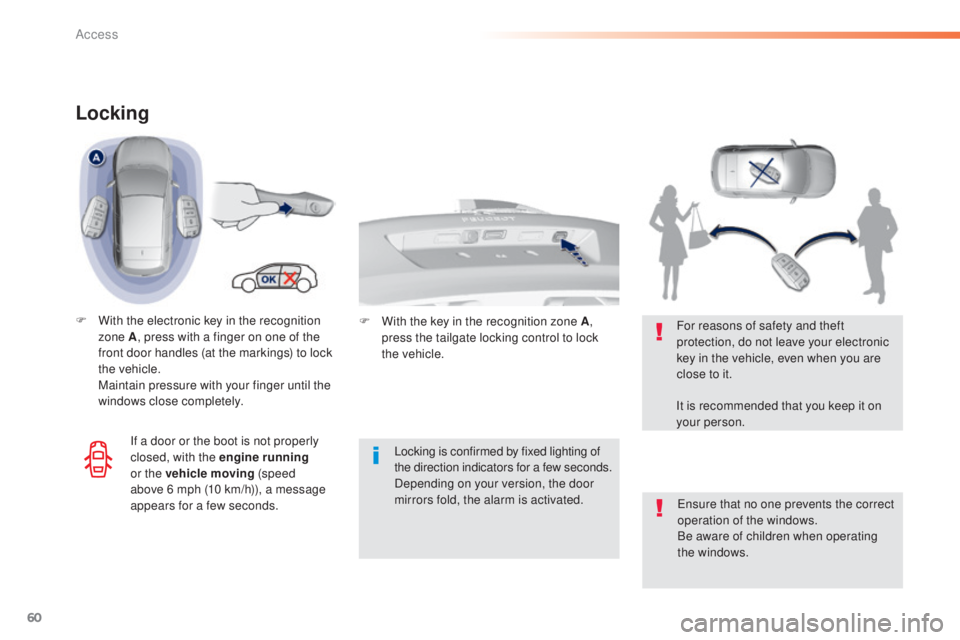
60
308_en_Chap02_ouvertures_ed01-2015
Locking
F With the electronic key in the recognition zone A , press with a finger on one of the
front door handles (at the markings) to lock
the vehicle.
M
aintain pressure with your finger until the
windows close completely.
Locking is confirmed by fixed lighting of
the direction indicators for a few
seconds.
Depending on your version, the door
mirrors fold, the alarm is activated.
en
sure that no one prevents the correct
operation of the windows.
Be aware of children when operating
the windows.
For reasons of safety and theft
protection, do not leave your electronic
key in the vehicle, even when you are
close to it.
It is recommended that you keep it on
your person.
If a door or the boot is not properly
closed, with the engine running
or the vehicle moving (speed
above 6
mph (10 km/h)), a message
appears for a few seconds. F
W ith the key in the recognition zone A,
press the tailgate locking control to lock
the
vehicle.
Access
Page 64 of 416
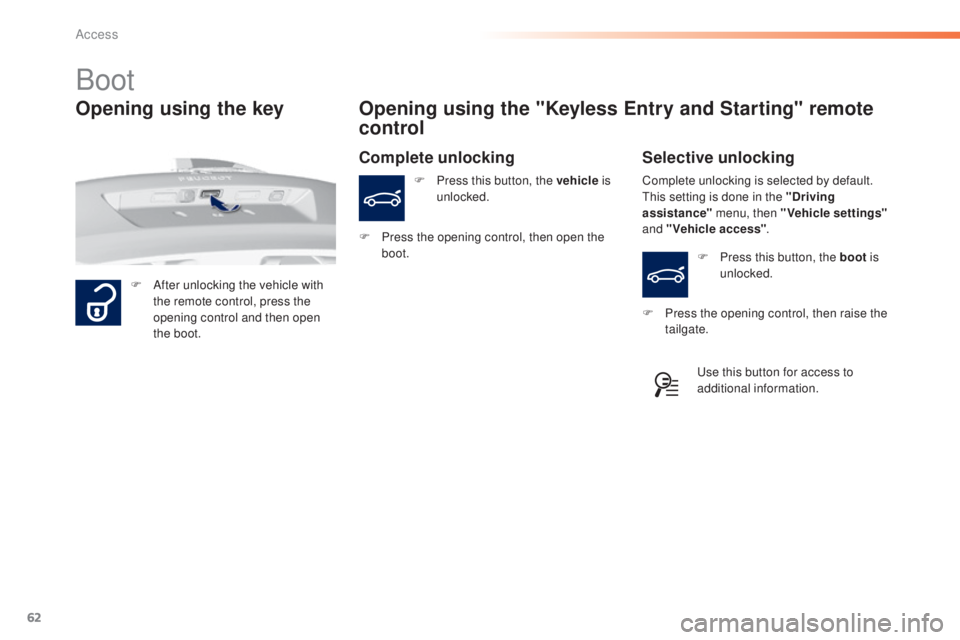
62
308_en_Chap02_ouvertures_ed01-2015
Boot
F After unlocking the vehicle with the remote control, press the
opening control and then open
the boot.
Opening using the "Keyless Entry and Starting" remote
control
F Press this button, the vehicle is
unlocked.
Opening using the key
Complete unlocking is selected by default.th is setting is done in the "Driving
assistance" menu, then "Vehicle settings"
and "Vehicle access" .
Complete unlocking Selective unlocking
F Press this button, the boot is
unlocked.
us
e this button for access to
additional information.
F
P
ress the opening control, then open the
boot.
F
P
ress the opening control, then raise the
tailgate.
Access
Page 65 of 416
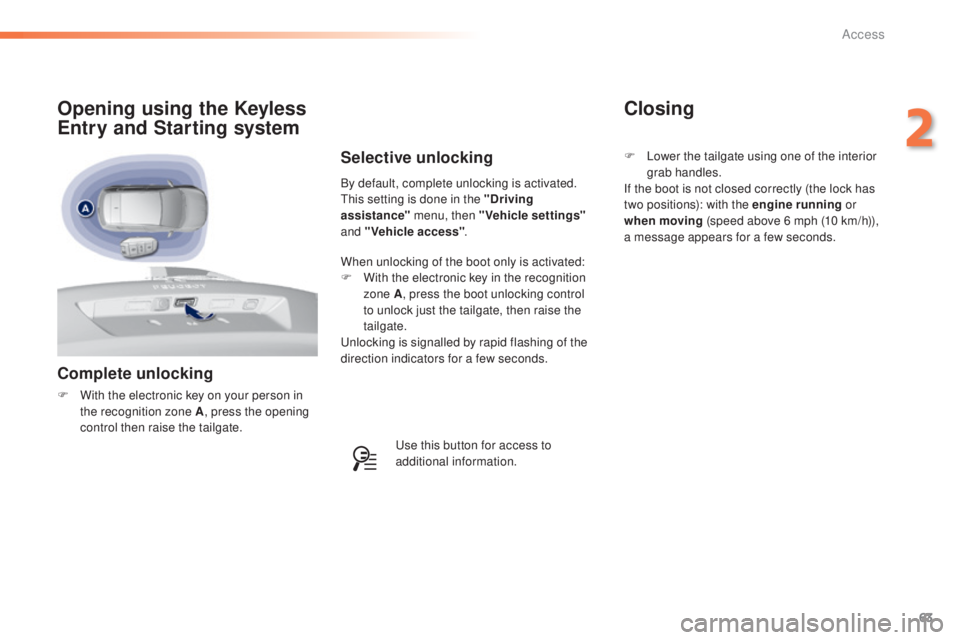
63
308_en_Chap02_ouvertures_ed01-2015
Complete unlocking
F With the electronic key on your person in the recognition zone A , press the opening
control then raise the tailgate.
Opening using the Keyless
Entry and Starting system
By default, complete unlocking is activated.th is setting is done in the "Driving
assistance" menu, then "Vehicle settings"
and "Vehicle access" .
Selective unlocking
When unlocking of the boot only is activated:
F
W ith the electronic key in the recognition
zone A , press the boot unlocking control
to unlock just the tailgate, then raise the
tailgate.
un
locking is signalled by rapid flashing of the
direction indicators for a few seconds.
us
e this button for access to
additional information.
Closing
F Lower the tailgate using one of the interior grab handles.
If the boot is not closed correctly (the lock has
two positions): with the engine running or
when moving (speed above 6 mph (10 km/h)),
a message appears for a few seconds.
2
Access
Page 66 of 416
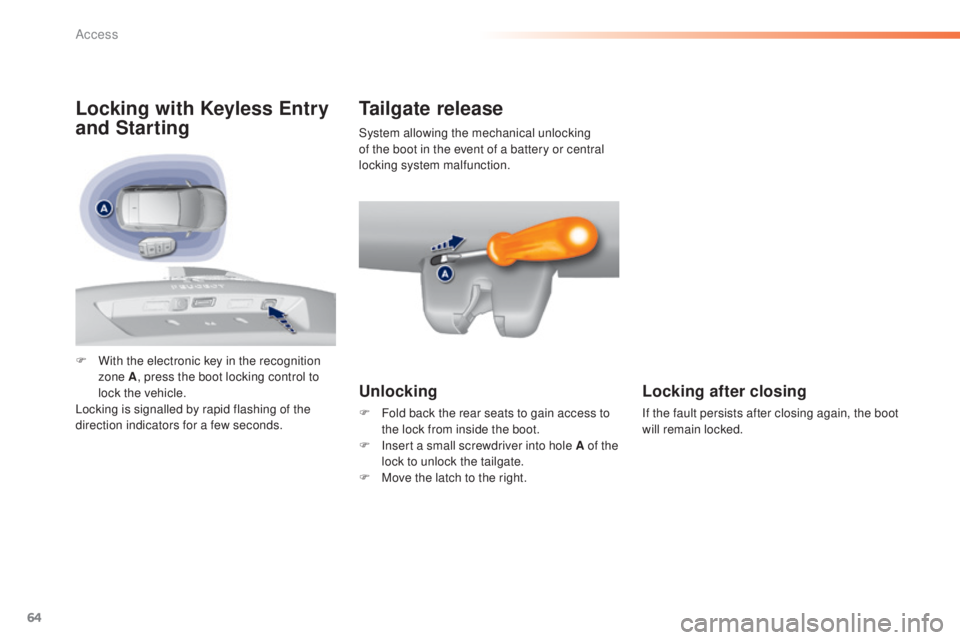
64
308_en_Chap02_ouvertures_ed01-2015
Tailgate release
Unlocking
F Fold back the rear seats to gain access to the lock from inside the boot.
F
I
nsert a small screwdriver into hole A of the
lock to unlock the tailgate.
F
M
ove the latch to the right.
Locking after closing
If the fault persists after closing again, the boot
will remain locked.
System allowing the mechanical unlocking
of the boot in the event of a battery or central
locking system malfunction.
F
W
ith the electronic key in the recognition
zone A , press the boot locking control to
lock the vehicle.
Locking is signalled by rapid flashing of the
direction indicators for a few seconds.
Locking with Keyless Entry
and Starting
Access
Page 171 of 416

169
308_en_Chap04_conduite_ed01-2015
Reversing camera
Opening the tailgate causes the display
to disappear.
the
reversing camera is activated automatically
when reverse gear is engaged.
Depending on version, the image is displayed
in the touch screen or the instrument panel. High pressure jet washing
When washing your vehicle, do not
direct the lance within 30 cm of the
camera lens.
the
superimposed representation of guide
lines helps with the manoeuvre.
th
ey are represented by lines marked "on
the ground" and do not allow the position of
the vehicle to be determined relative to tall
obstacles (for example: other vehicles, ...).
Some deformation of the image is normal.
th
e reversing camera cannot in any
circumstances be a substitute for
vigilance on the part of the driver.
th
e reversing camera function may be
completed with parking sensors.
th
e blue lines represent the general direction
of the vehicle (the difference corresponds to
the width of your vehicle without the mirrors).
th
e red lines represent a distance of about
30 cm beyond the edge of your vehicle's rear
b u m p e r.
th
e green lines represent distances of about
1
and 2 metres beyond the edge of your
vehicle's rear bumper.
the
turquoise blue curves represent the
maximum turning circle.
Clean the reversing camera regularly using a
soft, dry cloth.
4
Driving
Page 250 of 416
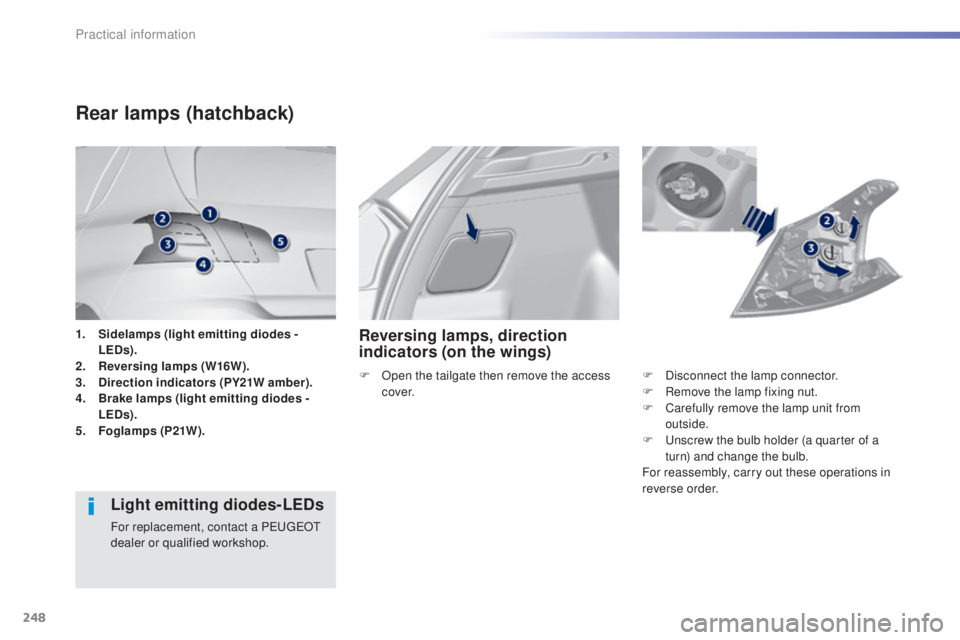
248
308_en_Chap07_info-pratiques_ed01-2015
1. Sidelamps (light emitting diodes - LEDs).
2.
R
eversing lamps (W16W).
3.
D
irection indicators (PY21W amber).
4.
B
rake lamps (light emitting diodes -
LEDs).
5.
F
oglamps (P21W).
Rear lamps (hatchback)
Light emitting diodes-LEDs
For replacement, contact a Pe ugeOt
dealer or qualified workshop.
Reversing lamps, direction
indicators (on the wings)
F Disconnect the lamp connector.
F R emove the lamp fixing nut.
F
C
arefully remove the lamp unit from
outside.
F
u
n
screw the bulb holder (a quarter of a
turn) and change the bulb.
For reassembly, carry out these operations in
reverse order.
F
O
pen the tailgate then remove the access
c ove r.
Practical information
Page 251 of 416
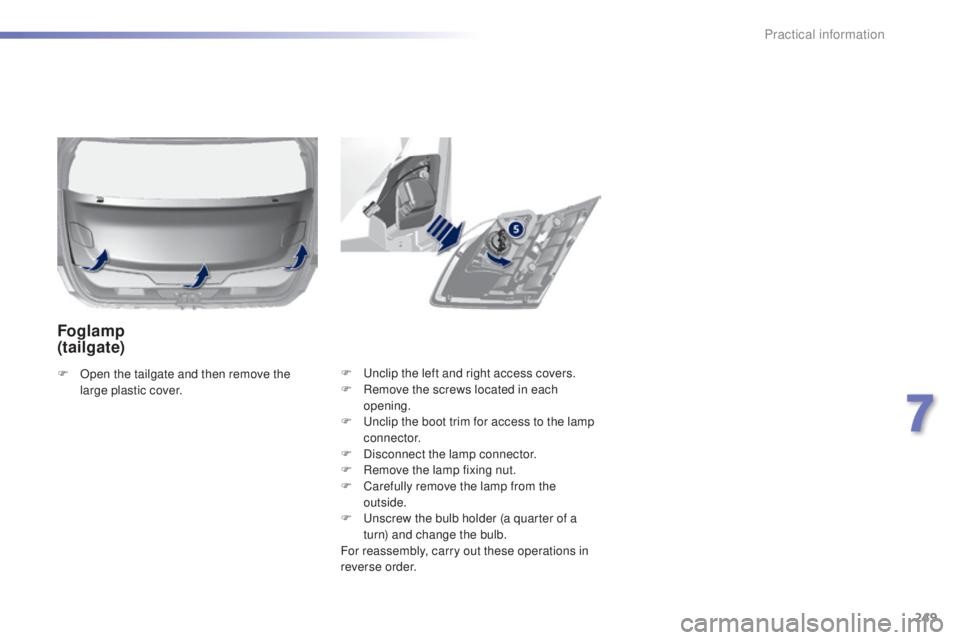
249
308_en_Chap07_info-pratiques_ed01-2015
F unclip the left and right access covers.
F R emove the screws located in each
opening.
F
u
n
clip the boot trim for access to the lamp
connector.
F
D
isconnect the lamp connector.
F
R
emove the lamp fixing nut.
F
C
arefully remove the lamp from the
outside.
F
u
n
screw the bulb holder (a quarter of a
turn) and change the bulb.
For reassembly, carry out these operations in
reverse order.
Foglamp
(tailgate)
F Open the tailgate and then remove the large plastic cover.
7
Practical information
Page 252 of 416
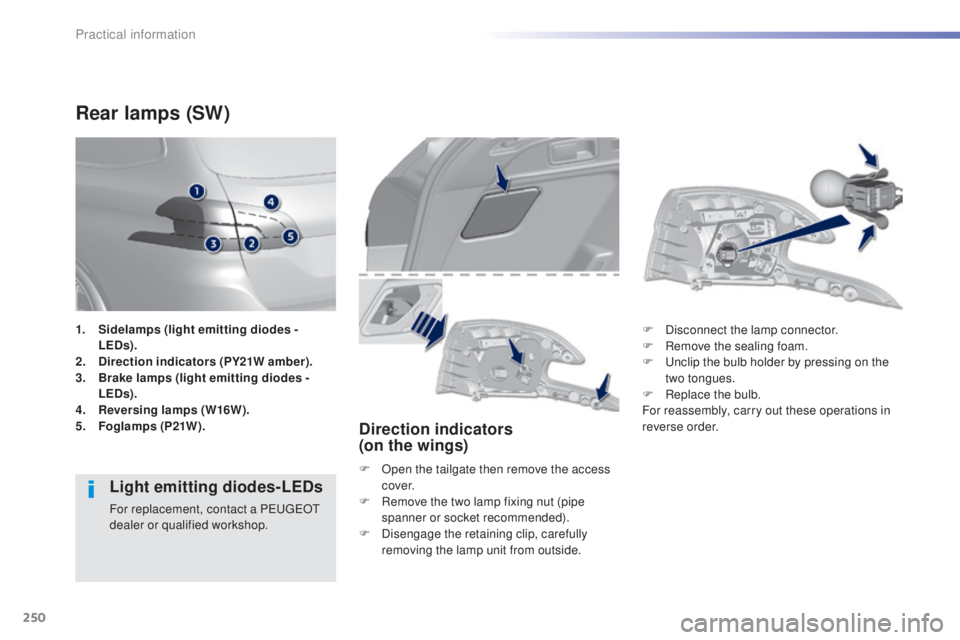
250
308_en_Chap07_info-pratiques_ed01-2015
Rear lamps (SW)
Light emitting diodes-LEDs
For replacement, contact a PeugeOt
dealer or qualified workshop.
Direction indicators
(on the wings)
F Open the tailgate then remove the access c ove r.
F
R
emove the two lamp fixing nut (pipe
spanner or socket recommended).
F
D
isengage the retaining clip, carefully
removing the lamp unit from outside. F
D
isconnect the lamp connector.
F
R
emove the sealing foam.
F u
n
clip the bulb holder by pressing on the
two tongues.
F
R
eplace the bulb.
For reassembly, carry out these operations in
reverse order.
1.
S
idelamps (light emitting diodes -
LEDs).
2.
D
irection indicators (PY21W amber).
3.
B
rake lamps (light emitting diodes -
LEDs).
4.
R
eversing lamps (W16W).
5.
F
oglamps (P21W).
Practical information
Page 253 of 416

251
308_en_Chap07_info-pratiques_ed01-2015
Reversing lamp, rear foglamp
(tailgate)
F Open the tailgate and then remove the access cover. F
C
arefully remove the lamp from the
outside.
F
D
isconnect the lamp connector.
F
F
oglamp: unclip the bulb holder by
pressing on the two tongues then replace
the bulb.
F
R
eversing lamp: turn the bulb holder a
quarter of a turn then replace the bulb.
For reassembly, carry out these operations in
reverse order.
F
R
emove the lamp fixing nut.
7
Practical information
Page 273 of 416
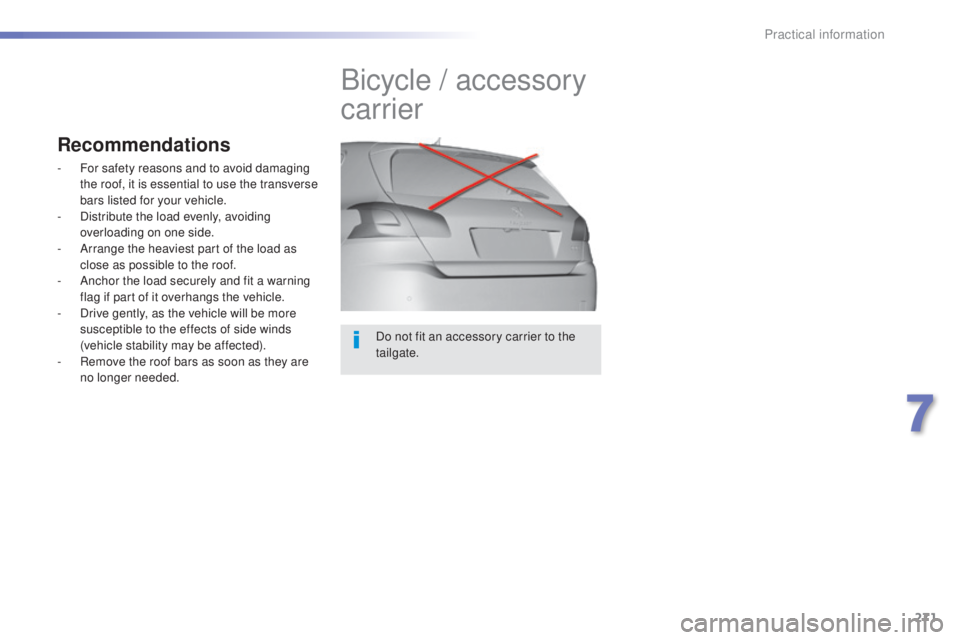
271
308_en_Chap07_info-pratiques_ed01-2015
Do not fit an accessory carrier to the
tailgate.
Bicycle / accessory
carrier
Recommendations
- For safety reasons and to avoid damaging the roof, it is essential to use the transverse
bars listed for your vehicle.
-
D
istribute the load evenly, avoiding
overloading on one side.
-
A
rrange the heaviest part of the load as
close as possible to the roof.
-
A
nchor the load securely and fit a warning
flag if part of it overhangs the vehicle.
-
D
rive gently, as the vehicle will be more
susceptible to the effects of side winds
(vehicle stability may be affected).
-
R
emove the roof bars as soon as they are
no longer needed.
7
Practical information